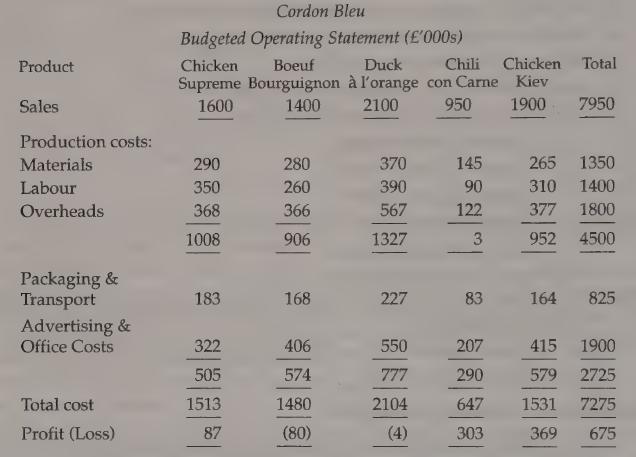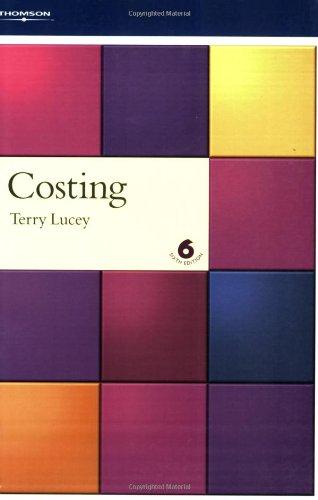Part A Cordon Bleu are rapidly expanding specialist food suppliers to restaurants, wine bars, pubs and similar
Question:
Part A Cordon Bleu are rapidly expanding specialist food suppliers to restaurants, wine bars, pubs and similar outlets. They buy, prepare and cook the ingredients which are then packaged, deep frozen and supplied to their customers who microwave or boil the meals before serving to their clients who are usually unaware that they are eating prepackaged meals. Cordon Bleu have five main lines; Chicken Supreme, Boeuf Bourguignon, Duck a l’orange, Chili Con Carne and Chicken Kiev.
Mike Commer has recently been appointed as Managing Director of Cordon Bleu after many years experience as a Director of a major national food manufacturer. He is in the process of reviewing all aspects of operations, especially the financial and sales side which he suspects have been neglected in the formative years of Cordon Bleu, when production and packaging difficulties absorbed most of the attention of John Watson, the founder, who is now Chairman of the company.
Mike asks Bill Hope, who is the Accountant and Office Manager, to prepare a Budgeted Operating Statement for the next period showing the profitability of the main product lines. Up to now there has been no attempt to show separately the profitability of the product lines and the exercise causes Bill a great deal of work. Finally he produces the following statement which, he admits, shows a surprising result and as a consequence he recommends to Mike that he should give serious consideration to cutting out the Boeuf Bourguignon and Duck a l’orange packs to avoid the losses.
The statement produced by Bill Hope was as follows:

Mike Commer studied the operating statement and suspected that there was more to the problem than the statement showed. Before coming to any decision he felt he needed more detail and sent for Bill Hope. After a lengthy meeting it was agreed that Bill Hope would supply the following additional information:
a. ananalysis of the fixed and variable elements of the various costs
b. clear guidance on the methods of allocation and apportionment used in the statement.
Fortunately Bill Hope had kept his working papers and was able to produce the required detail quite quickly. This was as follows:
Supplement to the Budgeted Operating Statement 1. Both labour and material costs are a combination of variable costs and a surcharge of 15% and 10% respectively to absorb general fixed costs. In the case of labour this is for general production supervision and general storage and ordering costs for materials.
2. Production overheads are a combination of variable overheads recovered on the total labour cost, general fixed overheads of £830,000 recovered on labour costs and directly attributable fixed costs as follows:

The directly identifiable fixed overheads would cease if the product was discontinued.
3. Packaging and transport costs consist of £150,000 general fixed overheads absorbed on labour costs, the balance being variable costs absorbed on total material costs.
4. Advertising and Office costs have three elements: Advertising costs absorbed on sales value, general fixed overheads of £100,000 also absorbed on sales value and directly attributable fixed costs as follows:

Once again the identifiable fixed costs would cease if the product was discontinued.
Questions:-
1. Comment on the position shown in the budgeted operating statement produced by Bill Hope.
2. Should the decision be taken at this stage to discontinue the two products shown making a loss? If not, why not?
3. What other information, additional to that in the Supplement, might be useful to Mike Commer in assessing the budgeted position ?
4. Redraft the budgeted operating statement in a more informative manner assuming that all five products will continue.
5. Comment on your redrafted operating statement explaining why it is more informative.
6. Prepare a new budgeted operating statement assuming that Boeuf Bourguignon and Duck a l’orange are discontinued and sales of the other products continue as budgeted.
7. Comment on the new statement.
8. What decisions should be taken about the product range?
Part B After his study of the financial aspects of Cordon Bleu’s operation, Mike turned his attention to the problems of Sales and Advertising. He commissioned a study from Rowe and Devenish, a market research agency specialising in the food and catering industry, to examine the impact of special product marketing and the extent of product substitutability.
Rowe and Devenish’s report was long and detailed but fortunately they provided a succinct summary as follows:
• Sales of any individual product could be increased by selective advertising, by up to 30% of the existing sales figures. An approximately linear relationship between sales increase and advertising expenditure was found eg, a 10%
increase in sales required 100% increase on existing advertising expenditure, a 20% increase a 200% increase and so on.
• Limited product substitutability is possible. For example, if Chili con Carne is offered as a substitute for Boeuf Bourguignon, each £1 reduction in sales of Boeuf Bourguignon causes a 60p increase in sales of Chili con Carne. If Chicken Kiev is the substitute, the increase is 50p more sales for each £1 reduction in Boeuf Bourguignon.
Questions:-
1. Investigate whether selective advertising is worthwhile.
2. Which products would be worthwhile advertising?
3. If advertising costs are limited to £150,000 which products should be advertised?
4. Should alternative products be substituted for Boeuf Bourguignon? If so, is Chicken Kiev or Chili con Carne a more profitable substitute.
Step by Step Answer:






